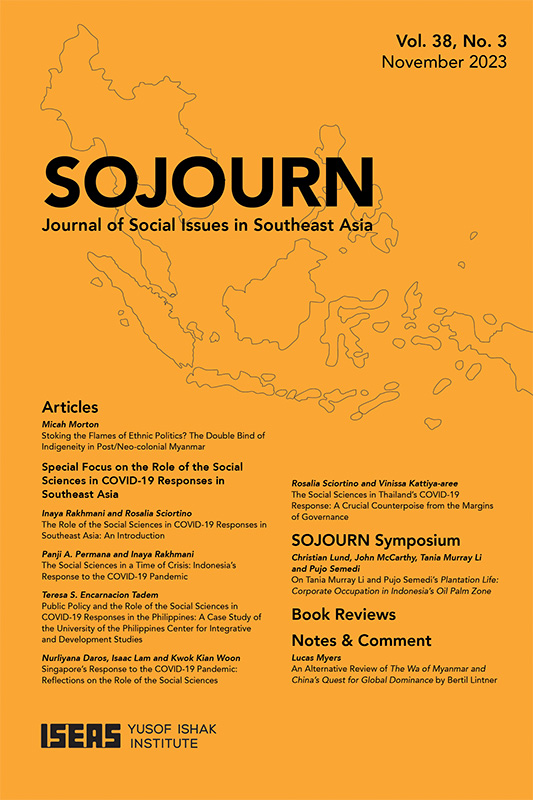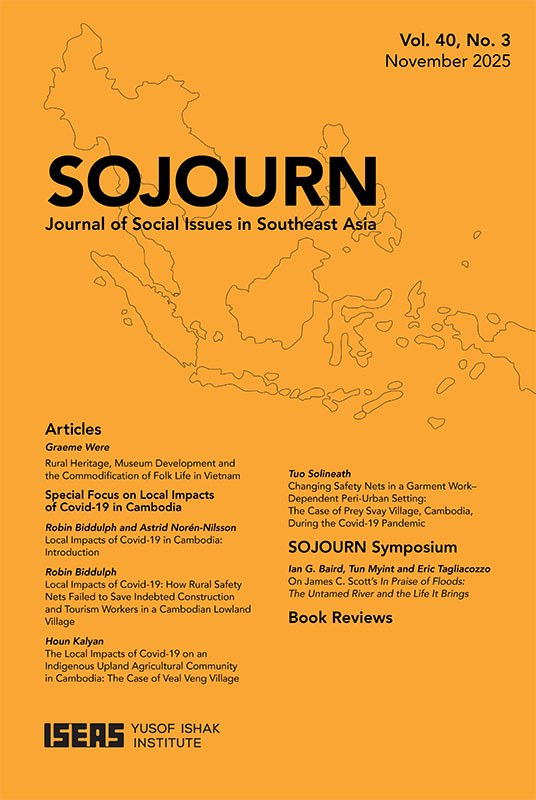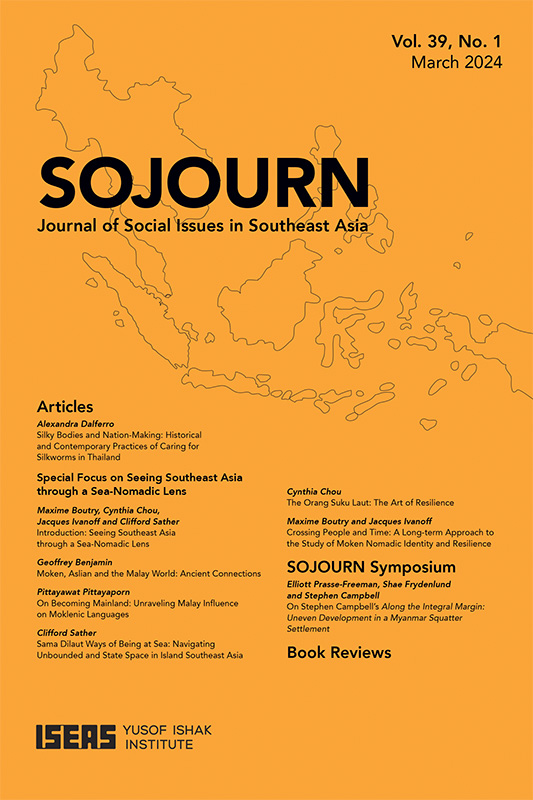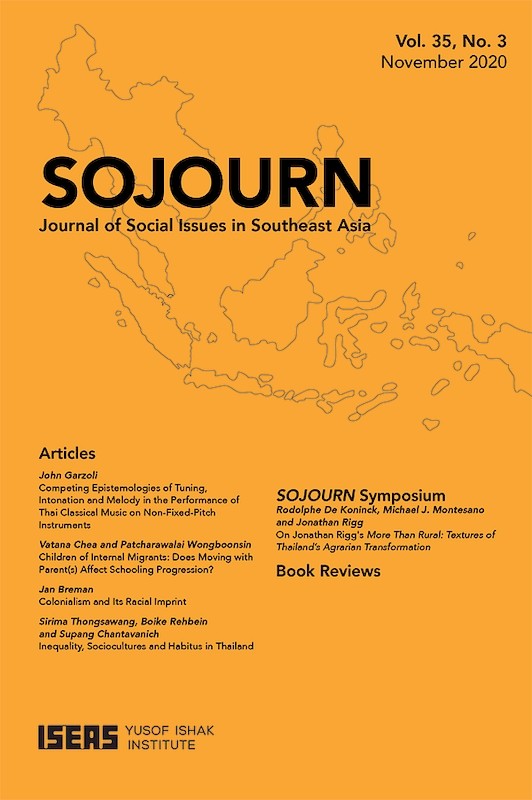SOJOURN: Journal of Social Issues in Southeast Asia Vol. 37/1 (March 2022)
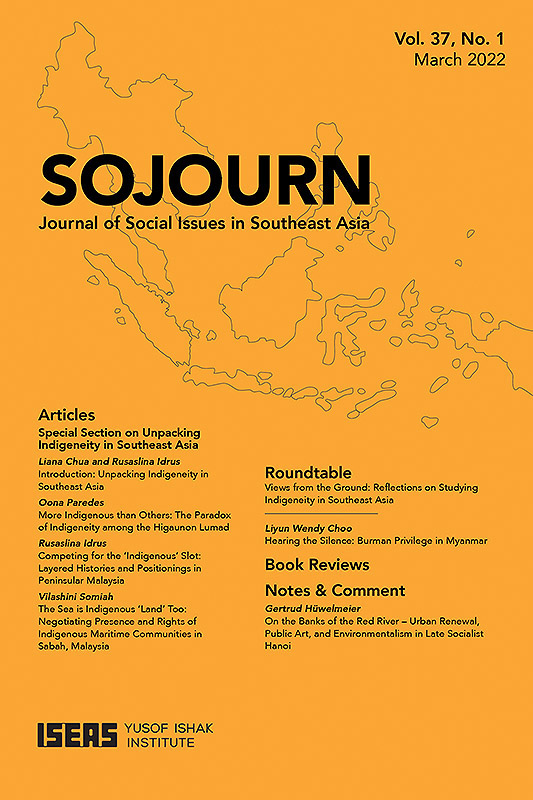
Date of publication:
March 2022
Publisher:
ISEAS – Yusof Ishak Institute
Number of pages:
200
Code:
SJ37/1
Soft Cover
ISSN: 02179520
Contents
-
SOJOURN: Journal of Social Issues in Southeast Asia Vol. 37/1 (March 2022)
[Whole Publication, ISSN: 17932858] -
Preliminary pages
- ARTICLES: SPECIAL SECTION ON UNPACKING INDIGENEITY IN SOUTHEAST ASIA
-
Introduction: Unpacking Indigeneity in Southeast Asia, by Liana Chua, Rusaslina Idrus, authors
-
More Indigenous than Others: The Paradox of Indigeneity among the Higaunon Lumad, by Oona Paredes, author see abstractIn the Philippines there is a stark disconnect between the static notion of indigeneity legalized by the state and an emic concept employed by Indigenous peoples themselves. This paper explores indigeneity as operationalized by the Higaunon of Mindanao, one of the island’s many Lumad or indigenous groups. Higaunons conceptualize ‘indigeneity’ as determined by ancestral pedigrees tied strongly to place and geography, and according to the precedence of founding ancestors, whose direct descendants are recognized universally as being ‘more indigenous’ than others. In the Higaunon case, indigeneity is a modern legal concept with both national and global pretensions, as well as a deeply embedded, pre-existing, highly localized cultural concept that overrides all other considerations. While efforts at poverty alleviation have seen Higaunons emphasize community unity, this indigenous/emic notion of indigeneity continues to intervene where ancestral precedence is at risk of being superseded by ‘universal’/etic notions of indigeneity that romanticize an egalitarian ethic and cultural inclination towards democratization. In Mindanao, at least, indigeneity as a working concept depends heavily on how such disconnects are negotiated and reconciled with respect to codes of national and customary law.
-
Competing for the ‘Indigenous’ Slot: Layered Histories and Positionings in Peninsular Malaysia, by Rusaslina Idrus, author see abstractIn Malaysia, multiple discourses of Indigenous rights have long existed in different forms: Malay, Orang Asli, bumiputera, natives, pribumi, Orang Asal, aboriginal—these are all terms that can be translated as ‘Indigenous’. New international Indigenous rights discourses are layered upon these existing discourses and become reworked, as do local forms of Indigenous identity claims. In this paper, I examine and explore the potential and limits of the claims to indigeneity in peninsular Malaysia as different groups at times align and clash in their claims for the Indigenous slot.
-
The Sea is Indigenous ‘Land’ Too: Negotiating Presence and Rights of Indigenous Maritime Communities in Sabah, Malaysia, by Vilashini Somiah, author see abstractIn Sabah, Malaysia, Indigenous communities continue to demand greater visibility and representation from the government. Citing the lack of political will, indigenes struggle to maintain their indigeneity and heritage, especially when it is so closely tied to place and possession, affecting their livelihoods and cultural practices. This becomes more precarious for Indigenous maritime communities, whose affinity with the sea is viewed by the Malaysian state as dangerous and inhospitable because of the sea’s fluid and motile nature. Set against the 2018 general elections and after, this paper unpacks narratives of survival, heritage and identity of Indigenous maritime residents.
- ROUNDTABLE
-
Views from the Ground: Reflections on Studying Indigeneity in Southeast Asia
- ARTICLES
-
Hearing the Silence: Burman Privilege in Myanmar, by Liyun Wendy Choo, author see abstractThe limited literature on Myanmar that touches on aspects of silence often associates it with hierarchies of authority, but silence can also be revealing of hierarchies of privilege. Drawing on Walton’s theorization of Burman-ness as Whiteness and photo-elicitation interviews with twenty young Myanmar citizens, this paper illustrates how Burman structures of privilege manifested empirically in the silence around ethnicity in Burman participants’ identity narratives. I argue that similar to Whiteness, Burman participants’ silence around their ethnicity demonstrates the invisibility of Burman-ness as the natural condition. It is critical to overturn these silences if Burmans are to work against systemic racism and in support of ethnic reconciliation.
- BOOK REVIEWS
-
BOOK REVIEW: Building Socialism: The Afterlife of East German Architecture in Urban Vietnam by Christina Schwenkel, by Soon-Tzu Speechley, author
-
BOOK REVIEW: Myanmar’s Education Reforms: A Pathway to Social Justice? by Marie Lall, by Hong Moon Suk, author
-
BOOK REVIEW: Uneasy Military Encounters: The Imperial Politics of Counterinsurgency in Southern Thailand by Ruth Streicher, by Anusorn Unno, author
-
BOOK REVIEW: Mosques and Imams: Everyday Islam in Eastern Indonesia, edited by Kathryn Robinson, by Claire-Marie Hefner, author
-
BOOK REVIEW: Monks in Motion: Buddhism and Modernity across the South China Sea by Jack Meng-Tat Chia, by Tan Lee Ooi, author
-
BOOK REVIEW: Indonesians and Their Arab World: Guided Mobility among Labor Migrants and Mecca Pilgrimsby Mirjam Lücking, by Sumanto Al Qurtuby, author
-
BOOK REVIEW: Living Kinship, Fearing Spirits: Sociality among the Khmu of Northern Laos by Rosalie Stolz, by Brett Le Saint, author
-
BOOK REVIEW: Abdullah Bin Abdul Kadir Munshi, Volume 1, His Voyages, Legacies and Modernity, Volume 2, His Voyages, Legacies and Colonial History by Hadijah Rahmat, by Kelvin Lawrence , author
- NOTES & COMMENT
-
On the Banks of the Red River – Urban Renewal, Public Art, and Environmentalism in Late Socialist Hanoi, by Gertrud Hüwelmeier, author

